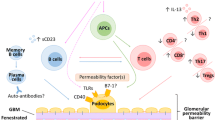Abstract
The pathogenetic basis of idiopathic nephrotic syndrome, a common childhood glomerulopathy, is being explored. While initial evidence supported an imbalance of T helper responses, recent studies suggest alterations in both innate and adaptive immune responses, including evidence for impaired T regulatory function. The central role of the podocyte in causing proteinuria is confirmed by the observation of mutations in key podocyte proteins in steroid resistant nephrotic syndrome and experimental evidence of altered podocyte signaling and cytoskeletal organization. The outcome and management of idiopathic nephrotic syndrome in children is determined by the response to corticosteroids and the frequency of relapses. While patients with steroid sensitive nephrotic syndrome have a favorable long term outcome, almost half of them relapse frequently and are at risk of adverse effects of corticosteroids. Although various non-corticosteroid immunosuppressive agents are used to prolong disease remission, careful monitoring is required for the potential adverse effects. Calcineurin inhibitors have emerged as the choice of therapy in patients with steroid resistant nephrotic syndrome. However, the management of this form of the disease is particularly challenging because of the variable response to immunosuppression, therapy-related significant adverse effects and high rates of disease progression to end stage renal disease. Patients with both corticosteroid sensitive and resistant forms of the disease are at risk of complications of disease, and require close monitoring and repeated counseling.




Similar content being viewed by others
References
Bagga A, Mantan M. Nephrotic syndrome in children. Indian J Med Res. 2005;122:13–28.
Löwik MM, Groenen PJ, Levtchenko EN, Monnens LA, van den Heuvel LP. Molecular genetic analysis of podocyte genes in focal segmental glomerulosclerosis-A review. Eur J Pediatr. 2009;168:1291–304.
Gigante M, Piemontese M, Gesualdo L, Iolascon A, Aucella F. Molecular and genetic basis of inherited nephrotic syndrome. Int J Nephrol. 2011; doi:10.4061/2011/792195
Araya CE, Wasserfall CH, Brusko TM, et al. A case of unfulfilled expectations. Cytokines in idiopathic minimal lesion nephrotic syndrome. Pediatr Nephrol. 2006;21:603–10.
Parikh SM. Circulating mediators of focal segmental glomerulosclerosis: soluble urokinase plasminogen activator receptor in context. Am J Kidney Dis. 2011; doi:10.1053/j.ajkd.2011.09.011
Zhang SY, Audard V, Fan Q, Pawlak A, Lang P, Sahali D. Immunopathogenesis of Idiopathic Nephrotic Syndrome. Contrib Nephrol. 2011;169:94–106.
Taylor PA, Lees CJ, Fournier S, Allison JP, Sharpe AH, Blazar BR. B7 expression on T cells down-regulates immune responses through CTLA-4 ligation via T-T interactions. J Immunol. 2004;172:34–9.
Barnett HL, Edelmann CM, Greifer I. The primary nephrotic syndrome in children. Identification of patients with minimal change nephrotic syndrome from initial response to prednisone. A report of the International Study of Kidney Disease in Children. J Pediatr. 1981;98:561–4.
Gbadegesin R, Lavin P, Foreman J, Winn M. Pathogenesis and therapy of focal segmental glomerulosclerosis: An update. Pediatr Nephrol. 2011;26:1001–15.
Dragovic D, Rosenstock JL, Wahl SJ, Panagopoulos G, DeVita MV, Michelis MF. Increasing incidence of focal segmental glomerulosclerosis and an examination of demographic patterns. Clin Nephrol. 2005;63:1–7.
Indian Pediatric Nephrology Group, Indian Academy of Pediatrics; Bagga A, Ali U, Benerjee S, et al. Management of steroid sensitive nephrotic syndrome: Revised guidelines. Indian Pediatr. 2008;45:203–14.
Hodson EM, Willis NS, Craig JC. Corticosteroid therapy for nephrotic syndrome in children. Cochrane Database Syst Rev. 2007; 4:CD001533.
Gipson DS, Massengill SF, Yao L, et al. Management of childhood onset nephrotic syndrome. Pediatrics. 2009;124:747–57.
Gulati A, Sinha A, Hari P, Bagga A. Daily corticosteroids reduce infection associated relapses in frequently relapsing nephrotic syndrome: a randomized controlled trial. Clin J Am Soc Nephrol. 2011;6:63–9.
Moudgil A, Bagga A, Jordan SC. Mycophenolate mofetil therapy in frequently relapsing steroid-dependent and steroid-resistant nephrotic syndrome of childhood: current status and future directions. Pediatr Nephrol. 2005;20:1376–81.
Gulati A, Sinha A, Jordan S, et al. Efficacy and safety of treatment with rituximab for difficult steroid resistant and dependent nephrotic syndrome. Clin J Am Soc Nephrol. 2010;5:2207–12.
Gulati A, Bagga A, Gulati S, Mehta KP, Vijaykumar M, on behalf of the Indian Society of Pediatric Nephrology. Management of children with steroid resistant nephrotic syndrome. Indian Pediatr. 2009;46:35–47.
Benoit G, Machuca E, Antignac C. Hereditary nephrotic syndrome: a systematic approach for genetic testing and a review of associated podocyte gene mutations. Pediatr Nephrol. 2010;25:1621–32.
Hodson EM, Willis NS, Craig JC. Interventions for idiopathic steroid-resistant nephrotic syndrome in children. Cochrane Database Syst Rev. 2010; 11: CD003594.
Colquitt JL, Kirby J, Green C, Cooper K, Trompeter RS. The clinical and cost effectiveness of treatments for children with idiopathic steroid-resistant nephrotic syndrome: a systematic review. Health Technol Assess. 2007;11:1–93.
Choudhry S, Bagga A, Hari P, Sharma S, Kalaivani M, Dinda A. Efficacy and safety of tacrolimus versus cyclosporine in children with steroid-resistant nephrotic syndrome: a randomized controlled trial. Am J Kidney Dis. 2009;53:760–9.
Gipson DS, Trachtman H, Kaskel FJ, et al. Clinical trial of focal segmental glomerulosclerosis in children and young adults. Kidney Int. 2011;80:868–78.
Vasudevan A, Mantan M, Bagga A. Management of edema in nephrotic syndrome. Indian Pediatr. 2004;41:787–95.
Conflict of Interest
None.
Role of Funding Source
None.
Author information
Authors and Affiliations
Corresponding author
Rights and permissions
About this article
Cite this article
Sinha, A., Bagga, A. Nephrotic Syndrome. Indian J Pediatr 79, 1045–1055 (2012). https://doi.org/10.1007/s12098-012-0776-y
Received:
Accepted:
Published:
Issue Date:
DOI: https://doi.org/10.1007/s12098-012-0776-y




